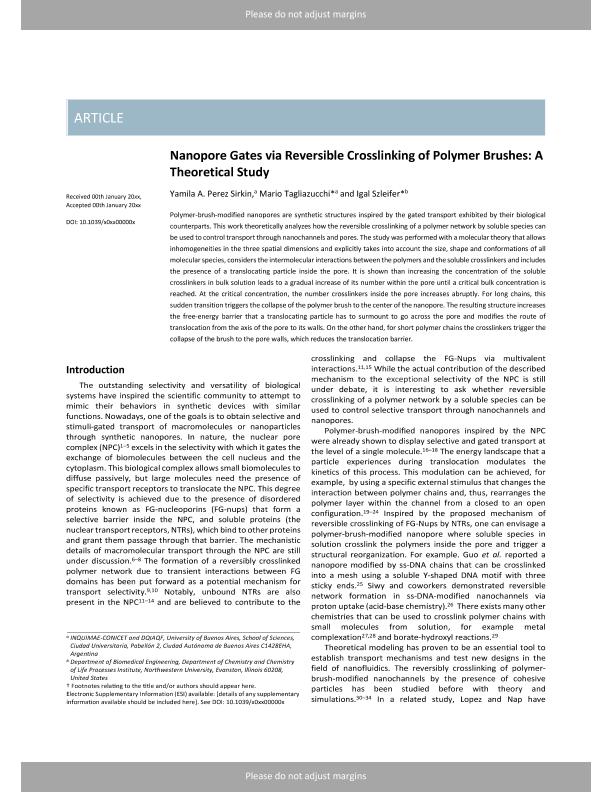Mostrar el registro sencillo del ítem
dc.contributor.author
Pérez Sirkin, Yamila Anahí

dc.contributor.author
Tagliazucchi, Mario Eugenio

dc.contributor.author
Szleifer, Igal

dc.date.available
2022-12-16T17:13:24Z
dc.date.issued
2021-03
dc.identifier.citation
Pérez Sirkin, Yamila Anahí; Tagliazucchi, Mario Eugenio; Szleifer, Igal; Nanopore gatesviareversible crosslinking of polymer brushes: a theoretical study; Royal Society of Chemistry; Soft Matter; 17; 10; 3-2021; 2791-2802
dc.identifier.issn
1744-683X
dc.identifier.uri
http://hdl.handle.net/11336/181586
dc.description.abstract
Polymer-brush-modified nanopores are synthetic structures inspired by the gated transport exhibited by their biological counterparts. This work theoretically analyzes how the reversible crosslinking of a polymer network by soluble species can be used to control transport through nanochannels and pores. The study was performed with a molecular theory that allows inhomogeneities in the three spatial dimensions and explicitly takes into account the size, shape and conformations of all molecular species, considers the intermolecular interactions between the polymers and the soluble crosslinkers and includes the presence of a translocating particle inside the pore. It is shown than increasing the concentration of the soluble crosslinkers in bulk solution leads to a gradual increase of its number within the pore until a critical bulk concentration is reached. At the critical concentration, the number of crosslinkers inside the pore increases abruptly. For long chains, this sudden transition triggers the collapse of the polymer brush to the center of the nanopore. The resulting structure increases the free-energy barrier that a translocating particle has to surmount to go across the pore and modifies the route of translocation from the axis of the pore to its walls. On the other hand, for short polymer chains the crosslinkers trigger the collapse of the brush to the pore walls, which reduces the translocation barrier.
dc.format
application/pdf
dc.language.iso
eng
dc.publisher
Royal Society of Chemistry

dc.rights
info:eu-repo/semantics/openAccess
dc.rights.uri
https://creativecommons.org/licenses/by-nc-sa/2.5/ar/
dc.subject
Nanpore
dc.subject
Polymer
dc.subject
Molecular Theory
dc.subject
Stimuli responsive
dc.subject.classification
Físico-Química, Ciencia de los Polímeros, Electroquímica

dc.subject.classification
Ciencias Químicas

dc.subject.classification
CIENCIAS NATURALES Y EXACTAS

dc.title
Nanopore gatesviareversible crosslinking of polymer brushes: a theoretical study
dc.type
info:eu-repo/semantics/article
dc.type
info:ar-repo/semantics/artículo
dc.type
info:eu-repo/semantics/publishedVersion
dc.date.updated
2022-10-03T18:49:46Z
dc.journal.volume
17
dc.journal.number
10
dc.journal.pagination
2791-2802
dc.journal.pais
Reino Unido

dc.description.fil
Fil: Pérez Sirkin, Yamila Anahí. Consejo Nacional de Investigaciones Científicas y Técnicas. Oficina de Coordinación Administrativa Ciudad Universitaria. Instituto de Química, Física de los Materiales, Medioambiente y Energía. Universidad de Buenos Aires. Facultad de Ciencias Exactas y Naturales. Instituto de Química, Física de los Materiales, Medioambiente y Energía; Argentina
dc.description.fil
Fil: Tagliazucchi, Mario Eugenio. Consejo Nacional de Investigaciones Científicas y Técnicas. Oficina de Coordinación Administrativa Ciudad Universitaria. Instituto de Química, Física de los Materiales, Medioambiente y Energía. Universidad de Buenos Aires. Facultad de Ciencias Exactas y Naturales. Instituto de Química, Física de los Materiales, Medioambiente y Energía; Argentina
dc.description.fil
Fil: Szleifer, Igal. Northwestern University; Estados Unidos
dc.journal.title
Soft Matter

dc.relation.alternativeid
info:eu-repo/semantics/altIdentifier/doi/http://dx.doi.org/10.1039/d0sm01760d
Archivos asociados
